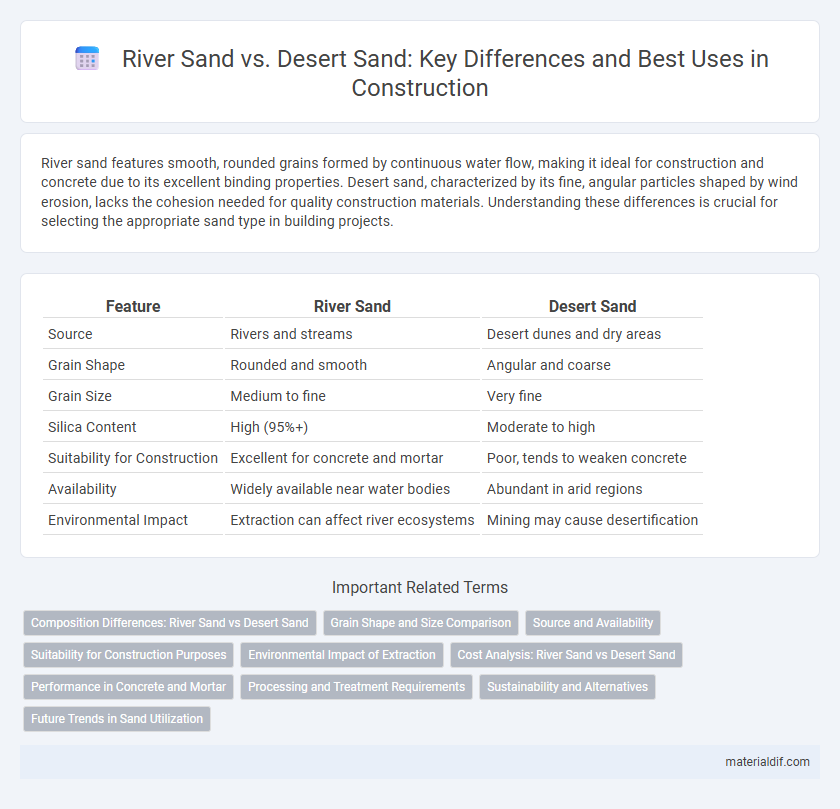River sand features smooth, rounded grains formed by continuous water flow, making it ideal for construction and concrete due to its excellent binding properties. Desert sand, characterized by its fine, angular particles shaped by wind erosion, lacks the cohesion needed for quality construction materials. Understanding these differences is crucial for selecting the appropriate sand type in building projects.
Table of Comparison
| Feature | River Sand | Desert Sand |
|---|---|---|
| Source | Rivers and streams | Desert dunes and dry areas |
| Grain Shape | Rounded and smooth | Angular and coarse |
| Grain Size | Medium to fine | Very fine |
| Silica Content | High (95%+) | Moderate to high |
| Suitability for Construction | Excellent for concrete and mortar | Poor, tends to weaken concrete |
| Availability | Widely available near water bodies | Abundant in arid regions |
| Environmental Impact | Extraction can affect river ecosystems | Mining may cause desertification |
Composition Differences: River Sand vs Desert Sand
River sand consists primarily of quartz and feldspar particles, resulting from continuous erosion and weathering by flowing water, which creates smooth, rounded grains with high silica content. Desert sand, shaped by wind erosion, contains finer, more angular grains with a higher proportion of heavy minerals and dust particles, often leading to variable mineral composition and lower overall purity. This fundamental difference in composition affects their suitability for concrete and construction, with river sand typically preferred due to its consistent grain size and mineralogy.
Grain Shape and Size Comparison
River sand features rounded, smooth grains resulting from continuous water erosion, with particle sizes typically ranging from 0.06 to 2 millimeters. Desert sand grains are more angular and coarse due to wind abrasion and minimal water transport, often displaying wider size variation between 0.1 and 1 millimeter. The fine, rounded grains of river sand enhance compaction and bonding in construction, whereas the angular shape of desert sand reduces its suitability for concrete.
Source and Availability
River sand, sourced from riverbeds and banks, is rich in minerals and organic materials, making it highly suitable for construction and concrete production. Desert sand originates from arid regions, characterized by finely rounded grains and low mineral content, limiting its use in structural applications. Availability of river sand fluctuates due to environmental regulations and extraction limits, whereas desert sand is abundant but less commonly exploited for industrial purposes.
Suitability for Construction Purposes
River sand is highly suitable for construction due to its rounded grains, optimal grain size distribution, and low salt content, which enhance concrete strength and durability. Desert sand, characterized by its fine, smooth, and uniform grains, lacks the angular texture necessary for proper bonding in concrete mixtures, making it less ideal for structural applications. Engineering standards and construction projects predominantly prefer river sand to ensure stability, longevity, and compliance with safety regulations.
Environmental Impact of Extraction
Extraction of river sand leads to significant environmental degradation, including riverbank erosion, loss of aquatic biodiversity, and disruption of natural water flow. Desert sand extraction has lower environmental impact due to its abundance and minimal disturbance to ecosystems but is less suitable for construction because of its grain shape. Sustainable management of river sand mining is critical to prevent severe ecological consequences and maintain water resource stability.
Cost Analysis: River Sand vs Desert Sand
River sand typically incurs higher costs due to extraction regulations, transportation complexities, and environmental restrictions, making it pricier in construction projects. Desert sand, abundant and cheaper to source, requires processing to improve particle cohesion and suitability, potentially offsetting initial savings with treatment expenses. Evaluating overall cost-effectiveness depends on project location, material availability, and processing technology used for integrating desert sand.
Performance in Concrete and Mortar
River sand, characterized by its round and smooth particles, enhances workability and bonding in concrete and mortar, resulting in improved strength and durability. Desert sand, with its fine, angular, and often overly uniform grains, tends to reduce concrete performance due to poor particle interlock and higher water demand. Optimizing concrete mix design with river sand significantly boosts compressive strength and reduces cracking compared to using desert sand.
Processing and Treatment Requirements
River sand requires minimal processing and treatment due to its natural washing and sorting by water flow, ensuring low clay and silt content. Desert sand demands extensive processing, including washing, drying, and sometimes chemical treatment, to remove fine particles and salts and enhance its binding properties. These treatment differences significantly impact the suitability and cost-effectiveness of each sand type in construction applications.
Sustainability and Alternatives
River sand, commonly used in construction, poses sustainability challenges due to excessive extraction leading to riverbank erosion and habitat loss. Desert sand, characterized by its smooth, rounded grains, is unsuitable for conventional concrete but offers potential as an alternative when processed or combined with binding agents. Sustainable alternatives include manufactured sand and recycled aggregates, which reduce environmental impact and preserve natural river ecosystems.
Future Trends in Sand Utilization
River sand remains the preferred choice in construction due to its ideal grain size and smooth texture, but increasing depletion drives the search for alternatives. Desert sand, characterized by its fine, rounded grains, is gaining attention through advanced processing techniques that enhance its binding properties for use in concrete. Future trends emphasize sustainable sourcing and innovative treatments to optimize desert sand's utility, reducing environmental impacts associated with river sand extraction.
River sand vs Desert sand Infographic

 materialdif.com
materialdif.com